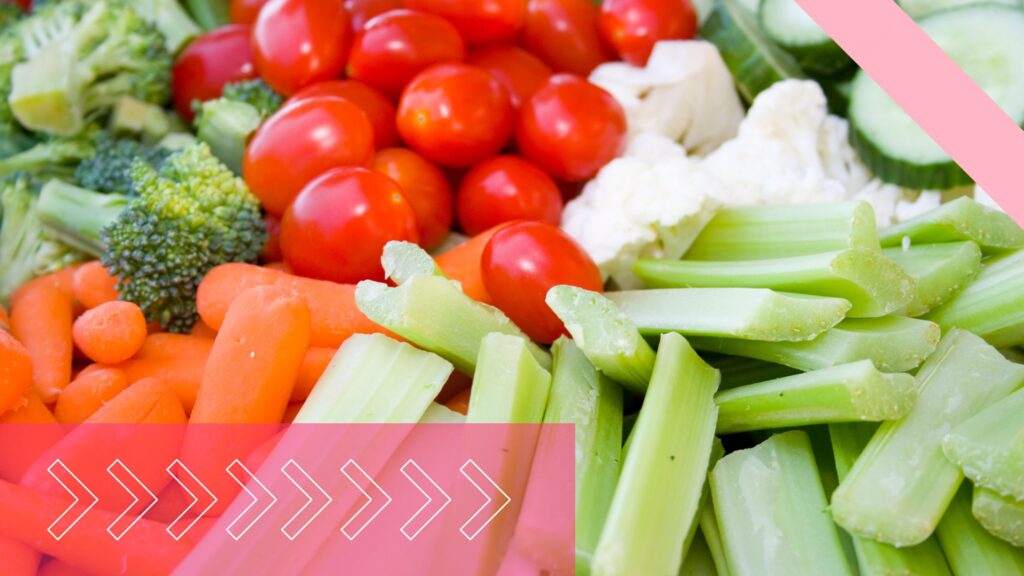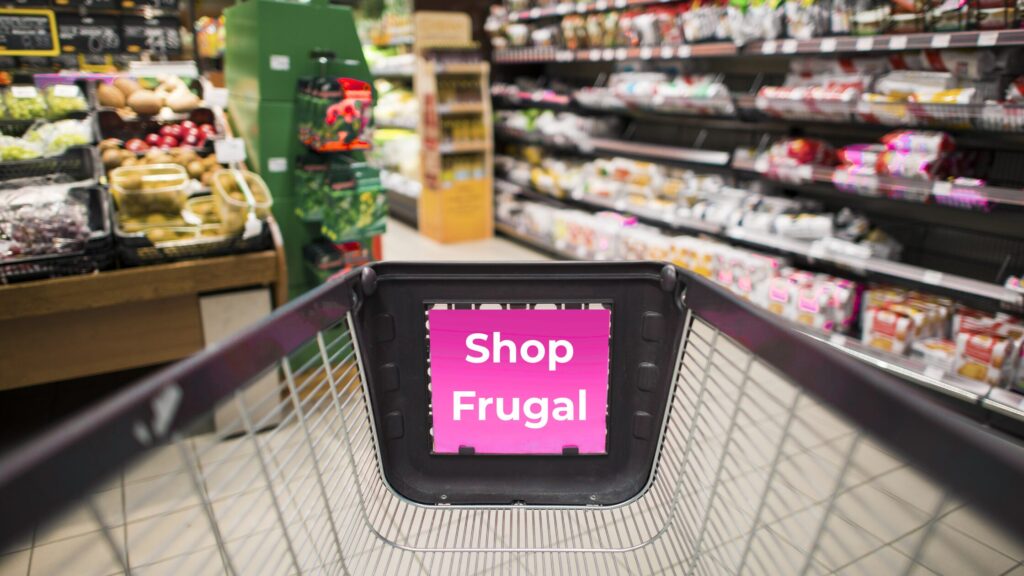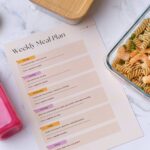Save money on groceries by meal-planning your week and shopping strategically. Stretch your budget further with seasonal, bulk, and markdown buys. Use price-tracking tools and smart swaps to save money on groceries without coupons.
Looking for ways to save money on groceries without clipping coupons? You’re not alone.
Overspending happens fast, believe me. I’ve had moments when the kids – or husband – snuck items into the cart. Worse yet, you’re in fight-or-flight mode and panic-buy to stretch the month. But you don’t need five jumbo jars of peanut butter; you need a plan that works.
You don’t have to sacrifice flavor or fun. It’s about making smart swaps, adopting better habits, and cultivating a mindset that says, “No thanks, $7 grapes.”
Repeat after me, “Groceries are not a luxury.”
I’ve been there…relying on food stamps, food pantries, and the kindness of others to get by. So these tips come from real experience, not theory.
This guide simplifies grocery shopping by spilling my best tips on how to save money on groceries without clipping coupons. In fact, it makes saving money downright doable and unapologetically frugal. And it doesn’t matter if you’re feeding a crowd or shopping solo. Ready to stop letting your grocery bill win? Let’s start with the coupon talk.
Disclaimer: This article contains affiliate links. I earn from qualifying purchases through these links at no additional cost to you.
Disclosure: I’m not a financial expert or a health professional. I don’t have a degree in finance, math, economics, or medicine. I’m just a gal who’s been there before. If you need professional advice, I recommend consulting an expert.
- How to Save Money on Groceries Without Coupons
- How Planning Meals Can Cut Grocery Costs
- Why You Should Always Use a Grocery List
- Is Pre-Cut Produce Worth It?
- How to Cut Your Grocery Bill Fast
- Why Fewer Grocery Trips Help Cut Costs
- Where to Shop to Save the Most on Groceries
- How to Save Money on Groceries Online
- Grocery Tips for Singles or Couples
- FAQ: How to Save Money on Groceries
- Start Saving Money on Groceries Like a Pro
How to Save Money on Groceries Without Coupons
I used to love watching the extreme coupon show on television. Loved it. I loved seeing the paper coupons fly out of those shoppers’ hands like falling autumn leaves tumbling across the road on a windy day. I loved watching that old analog cash register beep as the numbers leaped so fast that the register barely kept pace.
Then, I tried some of these couponing methods, but with limited success. And I realized a few things.
- Couponing done right is a lot of work and research
- Extreme couponing is not for your average grocery trip, and it’s not for me
- Timing is everything
Not everyone has time to chase sales, collect coupons, memorize every store app, or match coupons with sales. Ultimately, you have to decide what’s more important: your time or the effort required to pull off an extreme coupon haul. Alternatively, you could skip the extreme coupon idea and use your time for other things.
Coupons can be helpful, but only if they’re for items you already need and use. I’ll cover that topic another time. But they can also be a hassle when you’re super busy. You don’t need coupons to spend less at checkout. There are other ways to accomplish this goal. Let’s explore ways to save money on groceries without relying on coupons.

How Planning Meals Can Cut Grocery Costs
Plan your meals around what’s already in your fridge or pantry before making your list or heading to the store. That bag of rice is dinner now. You can use it in many ways, from a simple side of rice to pork, chicken, beef, or veggie-fried rice.
Asian- and Mexican-style dinners are our go-to when there’s extra rice lying around. But you can do so much more with rice, too! Taste of Home offers 63 delicious ways to use rice, providing a little inspiration if you need it.
Skip the name brands unless you can taste a difference. Store brands often come from the same factories anyway. They’re cheaper and usually just as good.
That said, I prefer to focus on quality. So, sometimes store brand makes sense for my family (powdered coffee creamer, milk, cottage cheese, bread, and yogurt, I’m looking at you!), and other times, I prefer certain brands (Skippy peanut butter, Maxwell House coffee, Angel Soft toilet tissue). It really depends on the products I’m buying.
Why You Should Always Use a Grocery List
Use a pen and paper or a digital app; either way, start with a list. Not in your head. A real one. Without a list, you risk forgetting something or buying something you don’t need. I made that mistake a couple of weeks ago.
Did I need a 26-oz container of salt? I thought I did. But as soon as I unpacked the groceries, I realized my mistake. I now have two 26-oz containers of salt in my cupboard. I have no idea what I’m going to do with them. Homemade Play-Doh? Maybe. I should have made a list… my mistake.
A shopping list keeps you focused. It also prevents impulse shopping or sneaky little temptations. Notice I said “prevents,” not “eliminates.” Impulse buys happen, and if you’ve got a habit of impulse spending, then either plan for it or plan for a deterrent.

Is Pre-Cut Produce Worth It?
Convenience costs more. Doing it yourself saves money and often yields more. A bag of whole carrots and celery hearts vs. pre-cut carrots and celery sticks? It’s a no-brainer for me. And if you use the carrot and celery sticks often enough, grab a couple of reusable containers (or wide-mouth jars) with tight-fitting lids.
Cut your carrots and celery sticks in advance and fill your containers. Add a little water and pop them in the fridge to get you through the week. You’ll save far more money by making your own veggie sticks than paying for the pre-cut ones.
How to Cut Your Grocery Bill Fast
Want to know how to lower your grocery bill without a complicated system? Start with snacks. The average American shopper spends 25% of their grocery budget on processed foods and sweets, including snack foods.
That’s a lot of money going towards processed foods and sweets! Think about it. According to Business Insider, the average monthly grocery bill for a thrifty American family of four in 2024 was about $977. And 25% of that (the amount typically going towards processed foods and sweets)? Approximately $244 per month. Yikes!
Snacks drain your budget faster than you think. Chips, cookies, sodas, and frozen treats sneak into the cart too easily. One bag of chips that used to cost $3 now costs $5, and sometimes more, depending on the brand, type of chip, bag size, and the store.
I recently bought sandwiches and a bag of chips for dinner one night after working late. It was a quick meal. I didn’t have to cook, but that convenience came at a cost. That one standard-sized bag: over seven dollars!
Frugal Tip: Choose one or two snack items per grocery trip and skip the rest. Regardless of what the kids think, you’re feeding people, not running a concession stand. And no, candy does not count as a valid dessert. One of my kids has tried that excuse, too.

Why Fewer Grocery Trips Help Cut Costs
Next, shop less often. This one may require some practice at first, but I promise it’s doable. Years ago, I lost my job and had to rely on SNAP benefits to feed my family. Because of how my benefits fell and how little food we had left by the time help arrived, I had to learn to budget for a full month.
Learning to grocery shop for an entire month at a time was hard at first, but we figured it out. Yes, we also used food pantries. Regular paychecks didn’t cover all the necessary expenses. So, carefully planning that monthly shopping trip was what saved my sanity and kept my family fed. There was no room for extras, no room for luxuries.
Fewer shopping trips mean fewer opportunities to pick up things you don’t need. You’ll save more on groceries and face fewer temptations. If you currently shop every week, consider stretching your grocery visits out to every 14 days. Fill your freezer and pantry during the big trip.
The first thing I grab is meat because it’s the most expensive. And I don’t buy boxed meals; I buy whole, fresh, or frozen meats because you get more value. Then, replenish perishables like milk, butter, and fresh produce. After that, I make my way up the aisles to gather the odds and ends (flour, sugar, cereal, condiments, etc.). You’ll waste less food and save more cash.
Frugal Tip: Take a calculator with you… An actual calculator that won’t turn itself off every 5 seconds. Remember to account for your state’s sales tax. This helps ensure you stay on par with your budget.
Where to Shop to Save the Most on Groceries
Each grocery store differs from the next, so check your local sales flyers for the best deals. You’ll still find the physical flyer at the store entrance. Alternatively, check the store website for the digital version. Or use a free comparison shopping app like Flipp.
Let’s talk about stores that keep it simple and make it easy to save money on groceries. You want fair prices, good food, and zero games. No digital coupon scavenger hunts.
Here are a few stores that actually deliver (this is not a complete list, and not all stores listed below are nationwide):
- Aldi: A no-frills winner for affordable basics.
- Amazon Fresh: Convenient grocery delivery, competitive pricing, and fast service for Prime members.
- Lidl: An East Coast fave in select locations that keeps prices low and offers decent quality.
- Costco, Sam’s Club, or BJ’s: Great for bulk staples if you have the space and a membership.
- Walmart: Strong for pantry staples, frozen items, and household basics.
- Save-A-Lot: Not fancy, but consistently offers low prices, especially in certain areas.
- Temu: Yes, you can actually find recognizable grocery brands on Temu, such as Mio, Fairlife, and more.
Wondering where else to shop to save money on groceries? Look for stores with everyday low prices, not flashy loyalty tricks. Consider visiting local packing stores, also known as meat markets or butcher shops. They’re often overlooked but can offer big savings on fresh meats and sometimes even deli cuts. A real deal saves your time, gas, and sanity.
Other great stops are often cultural grocery stores. You never know what you’ll find. We used to live in a small city in southern Maine with a local Asian food market. It was the best grocery store for fresh produce with reasonable prices. I loved that store! I could walk in with $20-$30 and walk out with a bag full of fresh and unique produce. Loved it!

How to Save Money on Groceries Online
Online grocery shopping has gained popularity, especially since the pandemic. And now, in some areas, you can even shop for food online via Amazon Fresh. And if you use SNAP benefits? You can enroll your EBT with Amazon Fresh. Unfortunately, this service is not available in my area, but it may be in yours.
Temu is another option, and an unexpected one at that. You can shop for bulk items from some of your favorite brands on Temu, and they ship directly from local U.S. warehouses.
However, as with anything, online grocery shopping can either save you serious cash or wreck your budget. Let’s focus on maximizing your potential and coming out ahead.
- Compare prices between store websites. Prices shift fast and not always in your favor. That’s especially true if your preferred brand or size is out of stock.
- Look for digital coupons and loyalty perks. But only if they’re easy and don’t eat up your time.
- Choose curbside pickup instead of delivery. It’s free at most stores, faster than shopping inside, and keeps you from tossing extras in the cart.
Ordering directly from stores also helps avoid third-party markups. That bag of rice shouldn’t cost more just because someone else grabbed it for you. Knowing how to save money on groceries online comes down to three things: stay picky, stay focused, and don’t trust the algorithm.
Grocery Tips for Singles or Couples
Grocery shopping for one (or two) can feel like a trap. You either overspend or throw half of it out. However, I also have some money-saving hacks to help you save money on groceries.
Buy ingredients you’ll use more than once. That big tub of fresh spinach? You won’t be eating it in four days unless you plan well.
Repeat after me, “Frozen fruits and veggies are friends.” They last longer, are more nutritious than canned (less salt and preservatives), and let you eat better without rushing and wasting.
Stick with small meat packs or split bulk items into freezer portions. I recommend the latter if you want to maximize savings. However, you’ll need quart-size freezer bags or vacuum-seal bags to repack individual portions. And you’ll need to repack them when you return home from shopping (before putting them in the freezer). That way, they’re ready to go when you are for any meal you choose.
Frugal Tip: This is the best time to marinate meat; it’ll save you time later. Add your marinade to the freezer bag along with your individual portion, and ensure a good seal. Then, toss it into the freezer until you’re ready to use it. You’ll save money without wasting a thing. And the meat will be pre-marinated when you’re ready to use it — no wait time.
FAQ: How to Save Money on Groceries
Saving money at the grocery store doesn’t have to mean clipping coupons or surviving on ramen. These quick answers address common questions about grocery budgets. You’ll find real ways to cut costs without giving up the foods you love.
Start Saving Money on Groceries Like a Pro
You don’t need a finance degree to figure out how to save money on groceries. You need a plan that actually works for your life. Use what you already have on hand first. Create a shopping list for everything else and stick to it. Stop letting snack aisles boss you around. And learn which local stores treat your wallet with respect.
A few small shifts can add up to big savings. Remember, you’re not chasing perfection; you’re making progress. You can eat well, spend less, and keep your pantry stocked without draining your paycheck.
Ready to shop smarter and keep more cash in your wallet and your emergency savings? Good. You got this!
Image Credit: © welcomia via Canva.com | © pixelshot via Canva.com | © scottiefone via Canva.com | © Изображения пользователя Ahanov Michael via Canva.com| © Kaspars Grinvalds via Canva.com
What to Read Next (Because You’re On a Roll)
- 11 Genius Money Hacks to Save More Cash
- Boost Your Emergency Fund Fast and Save Big
- 7 Simple Budgeting Tips for a Stress-Free Thanksgiving
- 27 Homemade Christmas Gifts That Wow






